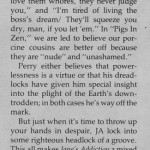BAM – July 3, 1987
Jane’s Addiction
Jane’s Addiction
Important/Triple X
by Cary Darling
Pgs. 28 & 30
Being a heavily hyped LA band is a burden no one should wish on his most vile enemy. Every year, the music industry offers up these fattened sacrificial lambs and watches them die due to public indifference. Meanwhile, an LA-based unknown like Bruce Hornsby comes along and sells records by the millions. Guess that’s just the way it is.
Jane’s Addiction are the latest in the line of hype bands, but, unlike so many of their predecessors, they aren’t just a marketing scheme in search of a market. The quartet’s indie-distrusted, self-titled debut album is hardly spectacular – it’s [sic] flaws outweigh its virtues – but it bodes well enough for their “official” first album on Warner Brothers later this year.
Recorded live at the Roxy, Jane’s Addiction is divided in half; side one is acoustic, side two is mostly electric, and it is these latter songs which are the most successful. JA are at their best when they crank up the Led Zep-inspired riffs and slam the up against some mighty cold funk bass and drum rhythms. “Trip Away,” “Whores,” “Pigs In Zen,” and “1%” all follow the pattern and easily outshine everything else on the album. The interplay between guitarist David Navarro, bassist Eric Avery, and drummer Stephen Perkins is remarkable at times, as on “Trip Away,” has a jazz edge.
What Jane’s Addiction are doing with their mix of shag-shakin’ metal and basic funk grooves is hardly new – George Clinton, Red Hot Chili Peppers, and Rick Rubin have been working a different and deeper end of the spectrum for years – but it’s still an involving blend of styles. JA’s blessing and curse is lead singer/lyricist Perry Farrell. He sings like a strangulated cat, with little shading or depth, which is why the acoustic songs are such a trial. But more problematic is the palpable sense that he feels he has something important to say and it leads him to some skewed sociological analysis which is pedestrian at best. What he didn’t pick up from Clinton, the Peppers, or Rubin was anything resembling a sense of humor.
While he paints an intriguing sketch of a woman on the skids in “Jane Says” and offers concise if elemental anti-government protest in “1%”, Perry falls off the rails on the remainder of the record. He seems to subscribe to some nouveau hippie world view that this planet’s outcasts are more moral than “straight” society merely because they have no control over their own fate. So, we get doses of offensive liberalism in “Whores” like “Way down low where the streets are littered / I get my fun with the freaks and the niggers,” “I love them whores, they never judge you,” and “I’m tired of living the boss’s dream / They’ll squeeze you dry, man, if you let ‘em.” “Pigs In Zen,” we are led to believe our porcine cousins are better off because they are “nude” and “unashamed.”
Perry either believes that powerlessness is a virtue or that his dreadlocks have given him special insight into the plight of the Earth’s downtrodden; in both cases he’s way off the mark.
But just when it’s time to throw up your hands in despair, JA lock into some righteous headlock of a groove. This all makes Jane’s Addiction a mixed affair. The curious might want to put down their spare change now, though a better bet might be to wait for the Warners record as their best songs (“Had A Dad,” “Ocean Size,” “Mountain Song”) are missing from this collection. Maybe an even better idea would be to get two turntables, copies of Led Zeppelin II and George Clinton’s Eunkentelechy [sic] Vs. The Placebo Syndrome, and play them simultaneously as loud as possible.
- Page 1
- Page 2



You must be logged in to post a comment.